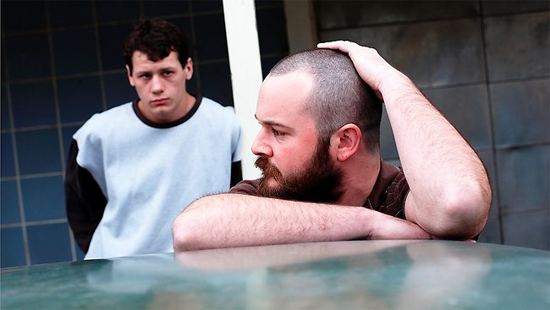Serial killers, both fictional and factual, are consistently popular subjects for film. They offer almost limitless potential for storytelling – from the lyrical Manhunter to the grotesque Henry, Portrait of a Serial Killer (both 1986), from the flashy Summer of Sam (1999) to the drab Monster (2003). Snowtown’s particular response to its subject is to take the part of a quiet observer, a documenter of dysfunction and poverty. Its approach does work to make it more than ‘just’ a thriller, but ultimately there’s not enough dignity or depth in any of the character portrayals to make it work fully as thriller or as social realism.
Snowtown tells part of the story of the ‘Snowtown murders’, a series of (at least) 11 killings perpetrated by John Bunting, with varying levels of assistance from several others. They happened between 1992 and 1999 around Adelaide, South Australia. The film takes the point of view of James Vlassakis, who became involved with Bunting at the age of 14 (the film’s starting point) and was later convicted of four of the murders. Vlassakis is alleged to have been troubled, a victim of abuse by his half-brother (who was later murdered by the gang). He was allegedly groomed as a killer by Bunting, and the extent to which he was coerced is a central enquiry of the film. He also became a prosecution witness in the trials of Bunting and conspirators Robert Wagner and Mark Haydon. Like all fictionalised accounts, Snowtown sticks rigorously to some facts and plays fast and loose with others, but but the choices it makes are interesting, not always conventional. Details of the torture some victims suffered are shown with brutal clarity, but basic facts like identities and chronologies are muddled, out of focus, the timeline fractured by unexplained shifts.
Snowtown is riddled with such tensions, many of which are disturbingly effective. Stillness and movement, sound and silence interact – long shots of blank, staring faces are interrupted by bursts of irritating noise. The film rarely allows you to be comfortable. It’s shot in a simplistic, often handheld style, giving the feeling that we’re in the rooms with these people, or just outside looking in. When it occasionally breaks this convention and uses cinematic tricks like sped-up footage to convey a sense of the boredom of time passing the effect is doubly sinister. But it’s somewhat jarring, too, and moves us further from the characters.
Similarly, there is a tension between the expressed motivation for the murders at the beginning – a hatred of paedophiles and a perception that no one in authority is doing anything about them – and the development of a sadistic brutality that clearly goes beyond the desire for revenge. But neither aspect brings much, if any, emotional engagement.There are glimmers of humanity; there is some love and affection, and even the psychopathic Bunting shows kindness sometimes, even if it it is just a means to manipulate others. But that’s the problem: the film’s flashes of humanity are just too superficial, and we never truly get to know the characters. There’s a dislocation between the intimacy of the camerawork and what is actually revealed. Perhaps this is a deliberate, very clever insight into the mentality of killers, but if so, it points to the film’s prioritisation of effect.
Better is Snowtown‘s exploration of ideas of lawlessness. It’s soon apparent that this community expects no action from the authorities, which leads to violence inside and outside homes and a nasty kind of vigilantism. When the characters get together to discuss what they see as the problem of paedophiles in the neighbourhood they speak with ignorance and hate. It’s a classic story of ringleaders charming and coercing others into agreeing with them and gradually wearing down their resistance to violence.
There’s something defensive about Snowtown’s insistence on making its part of Australia ugly and drab – no gorgeous Wolf Creek landscapes here, just grey skies, depressing kitchens and downtrodden people. One speech is the nearest thing it offers to a polemic. Bunting describes the kangaroo court vigilantism he advocates to cloak his own sociopathy as "Australian fucking tradition", claiming that Australia applauds those who kill and torture, that it’s a social duty.
Snowtown doesn’t follow the protocols of a traditional serial killer thriller, instead taking its cue from the bleak social realist school of Ken Loach and Shane Meadows. Unfortunately, that kind of film requires strong characters to drive the plot, and they are lacking here. There’s a lot that’s very ‘good’ in Snowtown – it’s a brutal, uncompromising addition to the serial killer film oeuvre, and serious attempt to say something about small towns everywhere and Australia in particular. It’s thought-provoking, harrowing and bleak, but the lack of emotional engagement means that Snowtown fails to deliver a punch to the gut.


